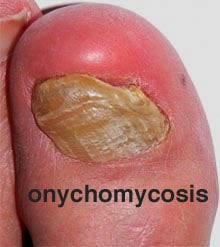The most common cause of yellowed, thick, and /or deformed toenails is a fungal infection of the toenail. The fungus that infects the nail, most commonly, is the same fungus that causes athlete’s foot. It tends to be slowly progressive, damaging the nail to a greater and greater degree over time. The infection usually starts at the tip of the nail and works its way back. It usually is not painful and often not noticed until it has gotten well established. A single toenail or any number of nails can be affected. It can also occur on just one foot. Over time, the nail becomes thickened, crumbly, and distorted in appearance. Sweaty feet, and working in wet conditions contribute to the initial infection process and to its spread. The fungus prefers an environment that is moist, dark, and warm, ie, in a shoe, which is why it affects the toenails much more often than fingernails. It does not spread through the bloodstream. The infection limits itself to the nails and skin. It is often found in association with areas of dry scaly skin on the bottom of the foot or between the toes. The dry scaling skin is frequently found to be chronic athletes’ foot. It is not highly contagious, and family members are almost as likely to contract it from some other source as they are from the family member who has the infection. Keeping common showering areas clean is recommended, and sharing shoes should be avoided.
Diagnosis
Not all thicken or yellowed toenails are caused by a fungal infection. Injury to a toenail can cause the toenail to grow in a thickened or malformed fashion. This can be due to an established fungal infection or may be due to the damage caused to the nail root when it was injured. In these instances, treatment with anti-fungal medications will not correct the malformed nail. Other causes of thickened toenails include bone spurs under the toenail as well as psoriasis. Taking a scraping of the toenail and culturing it makes the diagnosis.
Treatment
If treatment is desired, it is best to treat the condition sooner than later. Most over the counter medications do not work. Typically oral medication is the best treatment of fungal toenails. If sweating feet are a problem, changing shoes and socks during the day is recommended. There are some topical medications available that help to reduce the sweating of the feet. If you would like to help in combating nail fungus, please contact us at Family Podiatry and Vein Care. We are here for you!


